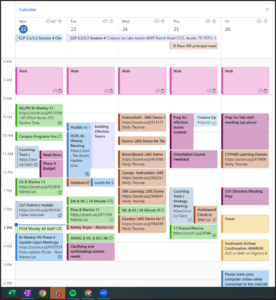A few weeks ago, we discussed ways schools can use structural supports to help teachers prioritize. Since writing, one thing has really stuck with me. . . only half the teachers I surveyed ever had a conversation about prioritization with their supervisor, boss, coach, manager or school or team leader!
As teachers—like anyone in education, really—we can work ourselves into the ground because the work we do is just so darn important.
While your habits are ultimately your own responsibility, there are a lot of things school leaders can do to help. We’ve gathered a few great examples from schools that really focus on this issue—to help improve outcomes and retain awesome teachers!
Tips for School Leaders:
- Make intentional space for a conversation about priorities—plan it, don’t wing it! This high school in Brooklyn built time in during a mid-year retreat for the discussion. Paul A., the principal, even set objectives the conversation.

- Walk in with data—use the past to drive your vision for the future. Bring to your meeting whatever data you’ve got around teacher satisfaction, retention, and workload. If your school or district doesn’t have any data, then issue a survey yourself. Or, have teachers track their time and bring their results to the meeting! Obviously, the power of anecdotal data should not be underestimated. How happy do your teachers seem? How late are they in the building? What are their biggest stressors?

- Clearly articulate “the why.” Paul and his team talked about prioritization by maintaining a purposeful focus on retention of great teachers. He says that most importantly, “A great school is about great teachers in every classroom. We can’t get there if our teachers are burning themselves out. We want to build a community school where kids can come back four, six or ten years down the line and see the same faces.”

- Be brave. Directly address cultural issues or mindsets that may underlie your team’s struggles to prioritize. Why hasn’t this worked before? What assumptions might your team have? What behaviors are YOU exhibiting as a leader? What messages do these send to your teachers? Create space to air and directly tackle these issues.

- Help teachers create an Ideal Week. There is a template attached here for your convenience. It may feel silly to help teachers plan down to this level of detail, but what we ask them to do is HUGE. Dedicating time to this task at a meeting or professional development session demonstrates your commitment to helping teachers lead more sustainable lives.

Once you HAVE this conversation, you’ll learn things about your team that you may have not considered before. All of this talk is one thing, but the hard part is keeping it alive.
I’m not saying I want you in the intimate details of each other’s personal lives, or that every staff meeting should be a Kum-Ba-Yah Love Fest. All I’m suggesting is that after you’ve considered the structural supports for prioritization, also remember to pause and think about how you can have a conversation with your staff around behaviors, unspoken norms, and what each team member models for one another.
Now go lead that conversation with your teachers!


